Publications
Of the Temporal and The Spiritual
Works By Avital Sheffer
Article by Inga Walton
Ceramics: Art and Perception No. 80 2010
In the northern rivers region of New South Wales at the foot of a large hill with pretensions called Mount Chincogan lies the improbably named town of Mullumbimby. Amidst the susurrus of a subtropical garden, fruit trees and a malapert display of flowering creepers in their gaudy finery, Avital Sheffer works from her spacious terracotta-and-blue clad studio, adjacent to her home. These harmonious surroundings are reflected in the tranquil and serene objects she produces, “I work on a group of vessels (10-15) in a period of about three months. I like this rhythm in the year as it corresponds with the seasons,” she says.
It may seem a somewhat incongruous place in which to find an artist born in the port city of Tel Aviv-Jaffa, whose background encompasses textile design and fashion, town planning and building design, classical homeopathy and the establishment of an alternative community in Western Galilee, where traditional farming methods were practiced in collaboration with neighbouring Arab villages. Sheffer migrated to Australia in 1990 for reasons which remain somewhat
elusive, even to her. “I had lived some life, one that was always marked by spontaneous changes. I migrated... upon an instinct; to this day, when asked for a reason, my answer is not clear. I was always a maker: of houses, landscapes, textiles and garments. Looking back it occurs to me that a ‘common thread’ going through all of these engagements was a curiosity and passion for disappearing traditions... I guess some of these sensibilities reincarnate in my ceramic work,” she muses.
Sheffer’s imposing urns, vases, pitchers and jars give the impression of having been unearthed from some previously undiscovered ancient resting place. It is an aesthetic deeply rooted in the centuries old cultural traditions of the Middle East but also embraces the architectonic in the way crumbling edifices, domes and dwellings are referenced. The subtle, tonal hues of the pigments and decoration are combined with the texture and ‘weathered’ quality of the surfaces, to forge a seamless contemporary expression of a ‘timeless’ theme. There has always been a latent compulsion towards the archaeological in Sheffer’s outlook, “Since I can remember I had an almost irresistible urge to dig in the ground, to find things, the earth was packed with thousands of years of fragments of human existence left behind, my imagination would continue lines and curves and make up the lost form, inanimate objects would then become animated,” she recalls. “I come from a traditional background which holds [an] appreciation for accumulated culture, for creativity and intuition that spring from knowledge of the past...”
It was this sense of the continuity and interconnection of material remnants that inspired Sheffer’s recently concluded exhibition Deep Earth, a mini-survey of 30 works which toured to five Australian public galleries, beginning in March 2009. “The awareness of the earth as the great repository, the archive of human endeavour, is part of my internal landscape. It is a result of growing up in a land that is so old and burdened, where the hidden will always be greater than the discovered,” she comments. “This is akin to the conscious and the subconscious in the collective memory. In a similar way, mystery has to be preserved in the work I make. I can not escape a sense of responsibility that the shards of the things I create should somehow communicate something to a person, to a child, in a thousand years.” In the context of a vast land with its own ancient indigenous cultures, the project encouraged viewers to contemplate their own private histories and origins. “The exhibition received a surprisingly strong emotional response from the public... I feel deep gratitude to Australia for being so inclusive and interested in the story of an insignificant migrant like me and wanted to give back what I could,” Sheffer reveals. “I wanted to show the complexity, the beauty and the pain of where I came from, and perhaps suggest that there is something universal in it.”
Sheffer’s work resonates with deeply held personal and philosophical convictions, “I perceive material and spirit as inseparable. I am a secular Jew; I belong to the people, the history, tradition and the gene pool but I am not religious as such,” she explains. “Humanity of all persuasions, even the most agnostic, harbours a deep need for ritual and custom, for the embodiment of the spiritual... in objects of meaning and beauty; I am interested in the manifestations of that need and in the conflicts it engenders...my inquiry naturally takes me on the path of the language I love and the stories of my ancestry, yet I am acutely aware of it being the story of humanity.” It was through this most primaeval material that Sheffer found an outlet compatible with the vehemence of her creative yearning. “I came to ceramics by chance; I fell in love with clay and hardly had a choice in the matter. Standing in front of clay vessels in the National Israel Museum, the course of my life had changed. I needed to make clay containers, ones that hold stories, hidden memories, and secrets...,” she stresses. “It was to become a way to reconcile my ‘split’ world... It provided me with a tool that is simultaneously a binocular and a magnifying glass.”
It is her utter absorption in the technical process and rigorous engagement with its artistic antecedents which prevents Sheffer’s work from being merely derivative, or drifting into the realm of faux historical. “I have been fully engaged in making since then, it has become the focus of my life and my full-time work, in which I am rather disciplined,” she maintains. “In the past five years I have been exhibiting back-to-back, with short periods of travel overseas for research and gathering of materials and periods of developing print work.” Sheffer begins by making plaster moulds in which she coils the bases of the vessels, then handbuilds the forms. Working in this way allows her to realise comparatively large shapes that spring from common beginnings and then assume their unique character. “They are like individuals within an extended family, or a tribe. When building the vessels I know where I start, with a familiar curve or line, but where they end up is always a mystery and a surprise. It is a bit like parenting children, where shared genealogy is expressed in peculiar and unpredictable personalities, a fine line between forming, shaping and accepting what comes, between knowledge and tentativeness,” she observes.
When the form is structurally completed, clay details are applied, “I perceive it as the deep skin of the work: scars, marks, perforations, age. At this stage I envisage some of the print work design that will come later; I create the canvas for it, yet leave room for the unexpected.” The building and drying process of such stately pieces demands Sheffer’s full presence and attention, “I am fortunate to be limited by the size of my kiln; I suspect I would make larger work otherwise. I feel comfortable with this scale... [it] invites engagement on both physical and emotional levels. People tell me they want to touch, to hug my pots, one woman told me she wants to put it to bed...,” Sheffer quips. “I spend long days, weeks in the solitude of my studio, I have a hand on my pots even when I’m asleep. I then apply engobes and dry glazes and fire several times until the surface is rich and ripe to receive the print work.” This represents one of Sheffer’s most exacting procedures, “The printing process is different to that of building with clay; my workspace goes through radical transformation when it turns into a printmaking studio and so do I; from working spontaneously, intuitively and being in my body, into a more intellectual and considerate process,” she agrees. “The business of printing is risky and unforgiving. The dry open surfaces of the vessels drink the oxides upon touch, any mistake in composition or less than perfect application results in the loss of the work. Clay teaches one not to be too precious; it is a constant reminder of how close endurance and perishability are.”
The imagery and texts Sheffer employs are selected for their visual and expressive qualities and the way they interact with the overall form. She gathers materials in museums, libraries and archives, then reworks, restores and transfers them to silk screens where they are kept in her visual library. They are developed from a wide range of sources: sacred texts, community archives, personal documents such as marriage deeds and love letters, scientific works, astronomical charts, as well as musical works and poetry. “I am nourished by this detective work, as it goes deeper into my personal roots. Deciphering the texts is not necessary for the understanding of and connecting with the work. I often take the freedom to restore, blare, abstract and cut the texts for that reason,” Sheffer offers. “They make reference to a slow and lasting form of information and communication...which has defied the ravages of time and the impermanence of memory...and pay tribute to the anonymous calligrapher whose hand I follow. The Hebrew texts are often placed against decorative elements, scrolls and arabesques, developed from a rich well of other Middle Eastern cultures, often Islamic, so a quiet conversation can take place suggestive of past and future possibilities of collaboration and interaction.”
It is, however, the present back-drop of prolonged enmity, bitterness and violence between Israel and its neighbours that belies Sheffer’s refined and ‘contained’ works. “I had left Israel frustrated and split-hearted. I was always associated with the peace movement, profoundly connected to the land but at odds with what the State had been doing in the past 40-odd years,” she acknowledges sadly. “It is a conflict-dominated society; two lovers fighting over the one land, prepared to annihilate each other and [commit] suicide rather than share. It is a tragic story of too many mistakes and missed opportunities that has led to a schism almost beyond bridging and time is not on anybody’s side. Add to that, I was tormented by guilt for leaving, being a stranger in both my old and my new country.” It is an irony not lost on Sheffer that her despair and frustration over events in her homeland have perhaps contributed to her becoming another member of the roving Jewish Diaspora. “A migrant experience of a place is naturally different to that of a native-born. The land where we grow up is a map in our internal geography... Coming from another place forces one into the interesting, if uneasy, position of being an outsider in both worlds,” she ruminates. “I don’t know that I could have the freedom, the distance and the safety to explore and to search in my art-making anywhere else [but Australia] and by this I feel at home now...the fact that my vessels sit comfortably in their strangeness here, tells me that I might begin to be part of this grand mosaic that is Australia.”
There is a certain inscrutable quietude and solemnity about Sheffer’s vessels, expressive of the emotive ties that bind those who wander in the world, displaced for innumerable reasons. “Looking back at the place I came from [Israel], I was desperately searching for some redeeming core elements and had to look at history and ask what it can tell me about my dilemmas and doubts,” she admits. “And what history tells me is that not much has changed during its course; it could simply be our make-up as human beings. The appetite for power, greed, the sentiment for religious dogma on one hand and the ability to cooperate, exchange, be generous and evolve on the other.” Conceivably it is the distance afforded by Sheffer’s current haven which has allowed her to grapple privately with issues which have not lost their potency through countless generations. “What I have learnt is that one can not change the world in any big way and the best I can do is create small opportunities for conversation [through her art]. Strangely, my work had been acquired by Arab collectors who find resonance in it... When people or countries converse and search for shared humanity, they are not likely to hate,” Sheffer posits. “I am pleased that the themes that inform my work (history, archaeology, ancient cultures) are now the subject of discussions, strangers approach me and we enjoy a moment of meaningful interaction. It seems that my work evokes in people a sentiment about their own history and that is immensely rewarding for me as an artist.”
Sheffer’s graceful vessels have an hypnotic quality, their undulating forms and graceful arcs murmuring to us softly of a universal artistic lineage and heightened spiritual consciousness. It is within their anthropomorphic bodies that Sheffer confides her misgivings, longing and aspirations, exorcises her feelings of unease and loss, then turns her discreet and wise accomplices over to us, so that we might do the same. “I search for clues in the personal and intimate relics that history left behind, in marks of individuality within the collective, in the tension they hold: quintessential and idiosyncratic forms, manuscripts and letters, the Divine that can be hand held,” she concurs. “Working in clay, with its primacy, transformations and its place as a provider of human needs from food receptacles to effigies and Gods, keeps one in a close embrace with this kind of spirituality.” As she toils away in thoughtful seclusion, Sheffer’s motivation is suitably poetic, “I am inspired by the artisan who sits on the shoulders of humble teachers; who draws on ancient knowledge and traditions; who finds fulfilment in acquiring and refining skills; who takes part in creating complex systems of beauty that resonate with the depth of the human spirit; who touches a place that is beyond time.” For the many who have been engrossed by her work over the past several years and await the future developments within her evolving practice, it will seem appropriate that Sheffer has unwittingly just described herself.
Inga Walton is a writer and arts consultant based in Melbourne, Victoria who contributes to numerous Australian and international publications. Articles published include one on Penny Byrne (Ceramics: Art and Perception, Issue 72) and “Clay Alchemy” (Ceramics TECHNICAL, Issue 27).
Avital Sheffer is a member of the International Academy of Ceramics. (www.avitalsheffer.com) Sheffer’s next solo exhibition in Australia, Continuum, will be at Anthea Polson Art, Queensland (21 August- 4 September, 2010) (www.antheapolsonart.com.au). All pieces featured are held in private collections.
Principal photos by David Young.
Studio photo below by Uri Karem.

Kederah I. 2009. Handbuilt, glazed and
printed,
multiple fired earthenware clay.
21 x 49 x 21 cm.
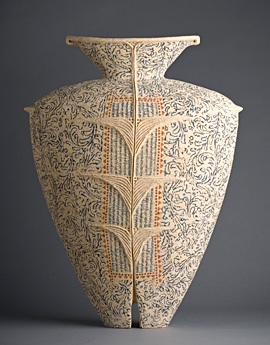
Omphalos VII. 2009. Handbuilt, glazed and
printed, multi- ple fired earthenware clay.
65 x 49 x 28 cm.
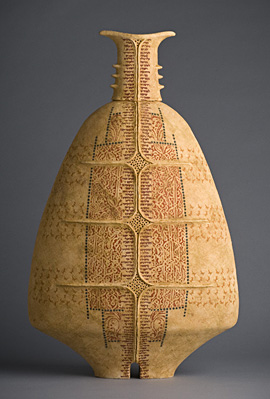
Meshalim I. 2009. Handbuilt, glazed and
printed, multiple fired earthenware clay.
62 x 38 x 21 cm.
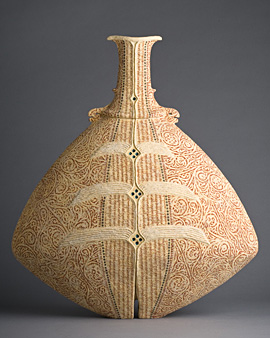
Poriyah II. 2009. Handbuilt, glazed and
printed, multiple fired earthenware clay.
62 x 56 x 24 cm.
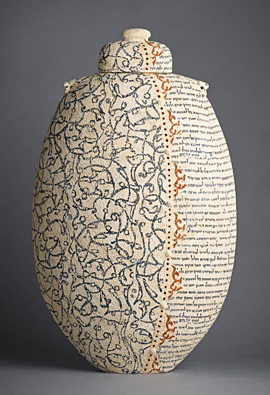
Aspaklaria VII. 2009. Handbuilt, glazed and
printed, multiple fired earthenware clay.
62 x 54 x 20 cm.
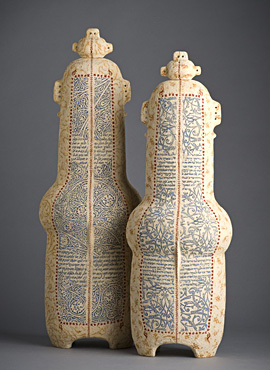
Elool I & II. 2009. Handbuilt, glazed and
printed, multiple fired earthenware clay.
63 x 21 x 17 and 58 x 21 x 17 cm.
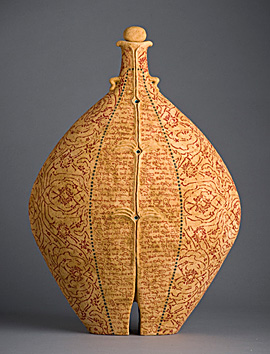
Marvaad I. 2009. Handbuilt, glazed and
printed, multiple fired earthenware clay.
55 x 38 x 22 cm.
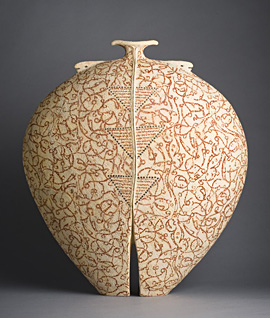
Kyklos II. 2009. Handbuilt, glazed and
printed, multiple fired earthenware clay.
61 x 55 x 26 cm.
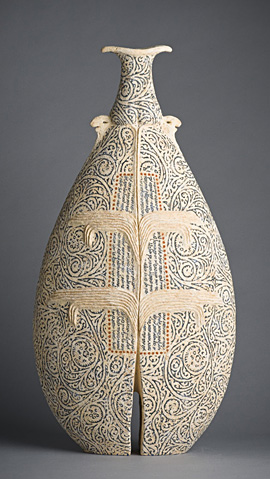
Inanah IV. 2009. Handbuilt, glazed and
printed, multiple fired earthenware clay.
65 x 32 x 19 cm.

Avital Sheffer in her studio.